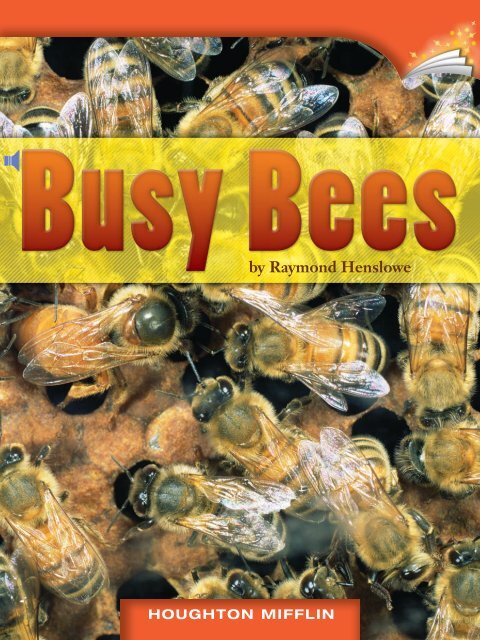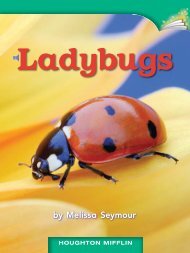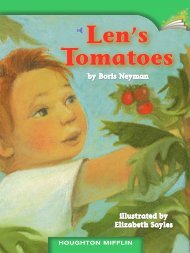You also want an ePaper? Increase the reach of your titles
YUMPU automatically turns print PDFs into web optimized ePapers that Google loves.
y Raymond Henslowe<br />
HOUGHTON MIFFLIN
y Raymond Henslowe<br />
PHOTOGRAPHY CREDITS: Cover Kim Taylor/npl/Minden Pictures. 1 Don Farrall/Getty Images. 2 Roger De La Harpe/ABPL/<br />
Animals Animals - Earth Scenes. 3 Steve Hopkin/Getty Images. 4 Kim Taylor/npl/Minden Pictures. 5 Colibri/Jupiter Images.<br />
6 Thomas Shjarback/Alamy. 7 imagebroker/Alamy. 8 David J Sams/Getty Images. 9 Don Farrall/Getty Images.<br />
10 AFP/Getty Images.<br />
Copyright © by Houghton Mifflin Harcourt Publishing Company<br />
All rights reserved. No part of this work may be reproduced or transmitted in any form or by any means, electronic or<br />
mechanical, including photocopying or recording, or by any information storage and retrieval system, without the prior<br />
written permission of the copyright owner unless such copying is expressly permitted by federal copyright law. Requests<br />
for permission to make copies of any part of the work should be addressed to Houghton Mifflin Harcourt School Publishers,<br />
Attn: Permissions, 6277 Sea Harbor Drive, Orlando, Florida 32887-6777.<br />
Printed in China<br />
ISBN-13: 978-0-547-02207-9<br />
ISBN-10: 0-547-02207-7<br />
1 2 3 4 5 6 7 8 0940 18 17 16 15 14 13 12 11<br />
If you have received these materials as examination copies free of charge, Houghton Mifflin Harcourt School Publishers<br />
retains title to the materials and they may not be resold. Resale of examination copies is strictly prohibited.<br />
Possession of this publication in print format does not entitle users to convert this publication, or any portion of it, into<br />
electronic format.
Kinds of <strong>Bees</strong><br />
<strong>Bees</strong> are always busy. Every bee has a job<br />
and a place to go. Hives have three kinds of<br />
bees. There are queens, workers, and male<br />
bees, called drones.<br />
2
The queen is the most important bee in<br />
the hive. Her job is to lay eggs. She lays about<br />
2,000 eggs every day! The eggs will hatch into<br />
new workers, drones, and queens.<br />
3
Some worker bees work inside the hive.<br />
They feed the queen and the drones. They take<br />
care of the queen’s eggs.<br />
4
Other worker bees work outside the hive.<br />
They guard the doors of the hive. They<br />
collect pollen and nectar from flowers and<br />
bring it back to the hive for all the bees to eat.<br />
<strong>Bees</strong> have long tongues to sip nectar from<br />
flowers. They collect the pollen on their back<br />
legs as they walk around inside each flower.<br />
5
The drones, or male bees, are the fathers<br />
of the queen’s eggs. Drones don’t do anything<br />
else. The worker bees feed the drones and<br />
clean them. There are usually only a few<br />
hundred drones in a hive.<br />
6
Beehives<br />
Worker bees build cells in the hive. These<br />
cells are called combs. The cells are made of<br />
wax. Each cell is shaped the same, with six<br />
sides. <strong>Bees</strong> store their food in some of the<br />
cells. They put eggs and young bees in other<br />
cells. The queen lives and lays her eggs in the<br />
deepest part of the hive.<br />
7
Sometimes there are too many bees in a<br />
hive. Then a queen leads some bees out to<br />
start a new hive. A group of bees looking for<br />
a new home is called a swarm. Swarms might<br />
hang on nearby tree branches while worker<br />
bees look for a place to build a new hive.<br />
8
When <strong>Bees</strong> Sting<br />
Sometimes animals attack a beehive. Then<br />
the worker bees that guard the doors of the hive<br />
sting the attacker. Other bees from the hive<br />
come to help the guards. Many animals cannot<br />
break through the swarm of bees. Even birds’<br />
sharp beaks are no match for bees.<br />
Eyes<br />
Stinger<br />
Head<br />
Wings<br />
9
Imagine you are walking along a winding<br />
trail in a forest. You walk past a beautiful pond<br />
and find a buzzing hive of bees. Don’t worry!<br />
If you leave the bees alone, they will not sting<br />
you. The bees are busy doing their jobs.<br />
10
Responding<br />
TARGET SKILL Text and Graphic<br />
Features What photographs are used in<br />
this book, and what do they show you<br />
Copy and complete the chart below.<br />
Photos<br />
Queen bee<br />
<br />
<br />
Page<br />
3<br />
<br />
<br />
What They Show<br />
Queen is largest bee<br />
How bee collects<br />
pollen<br />
<br />
Write About It<br />
Text to World What is the life of a queen<br />
bee like Write a few sentences that<br />
summarize her life. Remember to include<br />
only the most important parts of her life.<br />
11
TARGET VOCABULARY<br />
beaks<br />
branches<br />
break<br />
deepest<br />
hang<br />
pond<br />
shaped<br />
winding<br />
TARGET SKILL Text and Graphic<br />
Features Tell how words work with<br />
photos.<br />
TARGET STRATEGY Question Ask<br />
questions about what you are reading.<br />
GENRE Informational text gives facts<br />
about a topic.<br />
12
Level: L<br />
DRA: 24<br />
Genre:<br />
Informational Text<br />
Strategy:<br />
Question<br />
Skill:<br />
Text and Graphic Features<br />
Word Count: 417<br />
2.2.6<br />
HOUGHTON MIFFLIN<br />
Online Leveled Books<br />
1032098

















